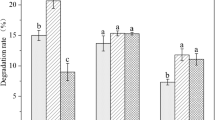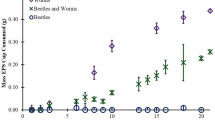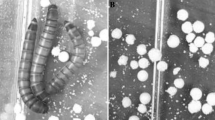Abstract
Mealworms from three different regions: Guangzhou, Tai’an and Shenzhen, were fed with three commonly used microplastics of polystyrene (PS), polyvinyl chloride (PVC) and low-density polyethylene (LDPE) for 1 month under favorable conditions, respectively. The survival rate and average weight of mealworms, the mass loss of microplastics and the production of frass were recorded every 4 days. Samples collected were characterized by X-ray diffraction, fourier transform infrared spectroscopy, thermogravimetric analyzer and gel permeation chromatography. The results showed that mealworms from Tai’an and Shenzhen could effectively metabolize the whole microplastics tested, while those from Guangzhou could only metabolize PS and LDPE. Besides, LDPE could be degraded by mealworms from Tai’an and Shenzhen, while those from Guangzhou showed no such capability, indicating that mealworms from different regions present different metabolism effects. Furthermore, PS and LDPE are more likely to be metabolized compared with PVC.



Similar content being viewed by others
References
Anthony, M., Niven, S. J., Galloway, T. S., Rowland, S. J., Thompson, R. C., & Browne, M. A. (2013). Microplastic moves pollutants and additives to worms, reducing functions linked to health and biodiversity. Current Biology, 23(23), 2388–2392.
Auta, H. S., Emenike, C. U., & Fauziah, S. H. (2017). Distribution and importance of microplastics in the marine environment: A review of the sources, fate, effects, and potential solutions. Environment International, 102, 165–176.
Bae, D. C., & Sik, K. K. (2009). Thermal characteristics of polyvinylchloride in combustion reaction using TGA. Journal of Korea Safety Management & Science, 11(3), 217–226.
Bergmann, M., Lutz, B., Tekman, M. B., & Gutow, L. (2017). Citizen scientists reveal: Marine litter pollutes Arctic beaches and affects wild life. Marine Pollution Bulletin, 125(1–2), 535–540.
Bhone, M. K., Ravi, C., Meena, K. S., Chu, S. L., & Kishore, R. S. (2012). Biodegradation of low density polythene (LDPE) by Pseudomonas species. Indian Journal of Microbiology, 52(3), 411–419.
Boborodea, A., Mirabella, F., & O’Donohue, S. (2016). Characterization of low-density polyethylene in dibutoxymethane by high-temperature gel permeation chromatography with triple detection. Chromatographia, 79(15–16), 971–976.
Browne, M. A., Crump, P., Niven, S. J., Teuten, E., Tonkin, A., Galloway, T., et al. (2011). Accumulation of microplastic on shorelines woldwide: Sources and sinks. Environmental Science and Technology, 45(21), 9175–9179.
Browne, M. A., Galloway, T., & Thompson, R. (2007). Microplastic—An emerging contaminant of potential concern? Integrated Environmental Assessment and Management, 3(4), 559–561.
Carniti, P., Gervasini, A., Beltrame, P. L., & Audisio, G. (1989). Evidence of formation of radicals in the polystyrene thermodegradation. Journal of Polymer Science Part A: Polymer Chemistry, 27(11), 3865–3873.
Chang, E. P., & Salovey, R. (1974). Pyrolysis of poly(vinyl chloride). Journal of Polymer Science: Polymer Chemistry Edition, 12, 2927–2941.
Chen, G. Z., Zhang, B. L., Ji, M. M., Wu, X. G., Zhou, J. Y., Chen, J. N., et al. (2017). Gut microbiota of polystyrene-eating mealworms analyzed by high-throughput sequencing. Microbiology China, 44(9), 2011–2018.
Conti, G., Santoro, E., Resconi, L., & Zerbi, G. (1988). FTIR spectra and structure of new polystyrene—Syndiotactic polystyrene and poly-para-methyl-styrene. Microchimica Acta, 1(1–6), 297–300.
Dokyung, K., Yooeun, C., & Youn, J. (2017). Mixture toxicity of nickel and microplastics with different functional groups on Daphnia magna. Environmental Science and Technology, 51(21), 12852–12858.
Eriksen, M., Mason, S., Wilson, S., Box, C., Zellers, A., Edwards, W., et al. (2013). Microplastic pollution in the surface waters of the Laurentian Great Lakes. Marine Pollution Bulletin, 77(1–2), 177–182.
Free, C., Jensen, O., Mason, S., Eriksen, M., Williamson, N., & Boldgiv, B. (2014). High-levels of microplastic pollution in a large, remote, mountain lake. Marine Pollution Bulletin, 85(1), 156–163.
Galloway, T. S., Cole, M., & Lewis, C. (2017). Interactions of microplastic debris throughout the marine ecosystem. Nature Ecology & Evolution, 1(5), 116.
Gong, F. L., Zhao, C. G., Feng, M., Qin, H. L., & Yang, M. S. (2004). Synthesis and characterization of PVC/montmorillonite nanocomposite. Journal of Materials Science, 39(1), 293–294.
Isobe, A., Uchiyama-Matsumoto, K., Uchida, K., & Tokai, T. (2017). Microplastics in the Southern Ocean. Marine Pollution Bulletin, 114(1), 623–626.
Ivar, J. A., & Costa, M. F. (2014). The present and future of microplastic pollution in the marine environment. Environmental Pollution, 185, 352–364.
Jeon, H. J., & Kim, M. N. (2013). Isolation of a thermophilic bacterium capable of low-molecular-weight polyethylene degradation. Biodegradation, 24(1), 89–98.
Leung, J., & Chan, K. Y. K. (2017). Microplastics reduced posterior segment regeneration rate of the polychaete Perinereis aibuhitensis. Marine Pollution Bulletin. https://doi.org/10.1016/j.marpolbul.2017.10.072.
Lwanga, E. H., Vega, J., Quej, V., Chi, J., del Cid, L., Chi, C., et al. (2017). Field evidence for transfer of plastic debris along a terrestrial food chain. Scientific Reports, 7(1), 14071.
Manojlovic, B. (1988). Influence of food and temperature on post-embryonal survival of yellow mealworm Tenebrio molitor L. (Coleoptera: Tenebrionidae). Zastita bilja, 183(39), 43–53.
Martin, W., & Scott, L. (2017). Freshwater microplastics: Emerging environmental contaminants? The handbook of environmental chemistry (Vol. 58). Frankfurt: Springer.
McNeill, I. C., Zulfiqar, M., & Kousar, T. (1990). A detailed investigation of the products of the thermal degradation of polystyrene. Polymer Degradation and Stability, 28(2), 131–151.
Moon, J., & Jeon, Y. (2008). Characterization of superlattices of monodisperse Fe3O4 nanoparticles in a polystyrene matrix with TEM and XRD. Superlattices and Microstructures, 43(2), 141–145.
Morales-Ramos, J., & Rojas, M. (2015). Effect of larval density on food utilization efficiency of Tenebrio molitor (Coleoptera: Tenebrionidae). Journal of Economic Entomology, 108(5), 2259–2267.
Nishizaki, H., & Yoshida, K. (1981). Effect of molecular-weight on various TGA methods in polystyrene degradation. Journal of Applied Polymer Science, 26(10), 3503–3504.
Parthasarathy, V., Dhanalakshmi, V., & Anbarasan, R. (2013). Thermal, melting and crystallinity behavior of esters grafted LDPE by thermolysis method. International Journal of Plastics Technology, 17(1), 61–74.
Phua, S. K., Castillo, E., Anderson, J., & Hiltner, A. (1987). Biodegradation of a polyurethane in vitro. Journal of Biomedical Materials Research, 21(2), 231–246.
Pielou, D., & Gunn, D. (1940). The humidity behaviour of the mealworm beetle, Tenebrio molitor L. I. The reaction to differences of humidity. Journal of Experimental Zoology, 17(3), 286–294.
Punzo, F., & Mutchmor, J. A. (1980). Effects of temperature, relative humidity and period of exposure on the survival capacity of Tenebrio molitor (Coleoptera: Tenebrionidae). Journal of the Kansas Entomological Society, 53(2), 260–270.
Reichert, J., Schellenberg, J., Schubert, P., & Wilke, T. (2017). Responses of reef building corals to microplastic exposure. Environmental Pollution. https://doi.org/10.1016/j.envpol.2017.11.006.
Roovers, J., & Toporowski, P. M. (1981). Preparation and characterization of H-shaped polystyrene. Macromolecules, 14(5), 1174–1178.
Sakai, W., Sadakane, T., Nishimoto, W., Nagata, M., & Tsutsumi, N. (2002). Photosensitized degradation and crosslinking of linear aliphatic polyesters studied by GPC and ESR. Polymer, 43(23), 6231–6238.
Satchwill, T., & Harrison, D. J. (1986). Synthesis and characterization of new polyvinylchloride membranes for enhanced adhesion of electrode surfaces. Journal of Electroanalytical Chemistry and Interfacial Electrochemistry, 202(1–2), 75–81.
Slichter, W. P., & Mandell, E. R. (1958). Molecular structure and motion in irradiated polyethylene. Journal of Physical Chemistry, 62(3), 334–340.
Sussarellu, R., Suquet, M., Thomas, Y., Lambert, C., Fabioux, C., Pernet, M., et al. (2016). Oyster reproduction is affected by exposure to polystyrene microplastics. Proceeding of the National Academy of Sciences of the United States of America, 113(9), 2430–2435.
Syberg, K., Nielsen, A., Khan, F. R., Banta, G. T., Palmqvist, A., & Jepsen, P. M. (2017). Microplastic potentiates triclosan toxicity to the marine copepod Acartia tonsa (Dana). Journal of Toxicology and Environmental Health-Part A-Current Issues, 80(23–24), 1369–1371.
Van Cauwenberghe, L., Vanreusel, A., Mees, J., & Janssen, C. R. (2013). Microplastic pollution in deep-sea sediments. Environmental Pollution, 182, 495–499.
Waller, C. L., Griffiths, H. J., Waluda, C. M., Thorpe, S. E., Loaiza, I., Moreno, B., et al. (2017). Microplastics in the Antarctic marine system: An emerging area of research. Science of the Total Environment, 598, 220–227.
Williams, P. T., & Williams, E. A. (1999). Fluidised bed pyrolysis of low density polyethylene to produce petrochemical feedstock. Pyrolysis, 51(1–2), 107–126.
Wooseok, L. (2017). A study of functionality and stability of LDPE-nano TiO2 composite film. Journal of Korea Society of Packaging Science & Technology, 23(2), 67–74.
Yang, S. S., Brandon, A. M., Flanagan, J., Yang, J., Ning, D. L., Cai, S. Y., et al. (2018). Biodegradation of polystyrene wastes in yellow mealworms (larvae of Tenebrio molitor Linnaeus): Factors affecting biodegradation rates and the ability of polystyrene-fed larvae to complete their life cycle. Chemosphere, 191, 979–989.
Yang, Y., Yang, J., Wu, W. M., Zhao, J., Song, Y. L., Gao, L. C., et al. (2015a). Biodegradation and mineralization of polystyrene by plastic-eating mealworms: Part 1. Chemical and physical characterization and isotopic tests. Environmental Science and Technology, 49(20), 12080–12086.
Yang, Y., Yang, J., Wu, W. M., Zhao, J., Song, Y. L., Gao, L. C., et al. (2015b). Biodegradation and mineralization of polystyrene by plastic-eating mealworms: Part 2. Role of Gut Microorganisms. Environmental Science and Technology, 49(20), 12087–12093.
Zhang, K., Hu, R. Q., Cai, M. M., Zheng, L. Y., Yu, Z. N., & Zhang, J. B. (2017). Degradation of plastic film containing polyethylene (PE) by yellow mealworms. Chemistry & Bioengineering, 34(4), 47–49.
Ziajahromi, S., Kumar, A., Neale, P., & Leusch, F. (2017). Impact of microplastic beads and fibers on Waterflea (Ceriodaphnia dubia) survival, growth, and reproduction: Implications of single and mixture exposures. Environmental Science and Technology, 51(22), 13397–13406.
Acknowledgements
The authors gratefully acknowledge the sponsorship from Shenzhen Municipal Development and Reform Commission (Discipline construction of watershed ecological engineering).
Author information
Authors and Affiliations
Corresponding author
Electronic supplementary material
Below is the link to the electronic supplementary material.
Rights and permissions
About this article
Cite this article
Wu, Q., Tao, H. & Wong, M.H. Feeding and metabolism effects of three common microplastics on Tenebrio molitor L.. Environ Geochem Health 41, 17–26 (2019). https://doi.org/10.1007/s10653-018-0161-5
Received:
Accepted:
Published:
Issue Date:
DOI: https://doi.org/10.1007/s10653-018-0161-5




